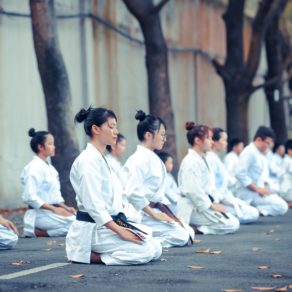Breaking a bad habit can be tough, but meditation may just be the key to success.
First, let’s define what we mean by “bad habit.” Maybe it’s biting your nails, overeating, or constantly checking your phone. Whatever it is, it’s something that you know you shouldn’t be doing, but can’t seem to stop.
Enter meditation. By taking a few minutes each day to sit in silence and focus on your breath, you can begin to gain control over your thoughts and actions.

Mindfulness meditation is a simple yet powerful practice that can transform your life. It involves being fully present in the moment, without judgment or distraction. By focusing on your breath and being aware of your thoughts and emotions, you can train your mind to be more resilient to stress and negative thoughts.
But it’s not just good for your mental health, regular meditation can also improve your physical health. Studies have shown that mindfulness meditation can lower blood pressure, decrease inflammation and even lower the risk of heart disease.
One of the most interesting benefits of meditation is how it can change the structure of your brain. Research has shown that regular meditation can lead to an increase in gray matter in the prefrontal cortex, which is responsible for decision making, attention, and empathy. This can lead to an overall increase in focus, attention span and a greater ability to empathize with others.
Meditation can also help with procrastination. When we’re stuck in a cycle of negative thoughts and self-doubt, it can be hard to take action. Mindfulness meditation can help us break this cycle by bringing us back to the present moment and encouraging us to take small steps forward.
Overall, mindfulness meditation is a simple yet effective way to improve your mental and physical health. It’s easy to get started and can be done anywhere, at any time. So, if you’re looking to improve your focus, lower your stress levels, and feel more connected to the world around you, give mindfulness meditation a try.
How to learn to meditate
Start by setting aside a specific time each day to meditate. This could be first thing in the morning, during your lunch break, or before bed.
Find a quiet, comfortable place to sit. You can use a cushion or a chair, just make sure you’re able to sit upright with your back straight.
Start by keeping your head, trunk and neck straight. Your tongue should touch the upper palate of your mouth.
Now close your eyes.
Mentally survey your body
Keep your neck, head and trunk in a straight line
Systematically survey your body from head to toe and from toe to head.
Your body is comfortably steady
Now you pay attention towards your breath . Your mind is going with the flow of your breath. If you hear any noises it will help you to even relax further. There is no obstruction. You do not keep a large pause between your in and out breath. When you exhale you push in your abdomen. Inhale and let your abdomen come out. Don’t force your inbreath. Let it come naturally. At your outbreath use a little bit of force when you push in your abdomen. That will help your diaphragm to push into your lungs and to exhale whatever is not needed in your system.
Form this habit: when you are exhaling you exhale what is not needed in your system. Exhale all your negativity. Exhale all your fear and problems
Now you inhale fresh energy from the cosmos. Fill up your whole being with that energy. Be aware of the fact that when you inhale you inhale positive energy and you exhale what is not needed.
Your whole body is fully relaxed. Let your mind follow the flow of your breath. Let your mind pay attention to the place between the 2 nostrils.
Let both nostrils feel the breath clearly when you are inhaling and exhaling.
Now let your mind be focused between the 2 eyebrows. Here you are allowing yourself to understand your thoughts. Any thought that comes in front of you you should learn to let go. Imagine that you open a trunk, you put the thought inside and you close the lid.
Your senses are your instruments. The mind is your finest instrument. You are beyond, breath, sense and mind. You are not identifying yourself with your mind or body. Your essential nature is peace, happiness & bliss.
Now you are remembering your Mantra – if you do not have a Mantra you can use the universal mantra OM. Your Mantra is leading you into silence. You have started listening to the Mantra which is coming from space & the center of your 2 eyebrows.
Your tongue is not moving. Your mind is not remembering but listening to the mantra. The mantra is leading the mind to silence.
Stay in this space as long as you can.
Now, start again to listen to your Mantra. Remembering your Mantra, you are paying attention to your breath again. Listen to your surroundings. Feel your fully relaxed body. Slowly move your body.
Put a smile on your face and gently open your eyes.
The key to meditation is to stick to one method since otherwise you cannot train your mind. You start by going inside and you end it by coming back being aware of sounds, your surroundings, your breath and your body.
SWAMI RAMA
This meditation practice draws inspiration from the teachings and techniques of the revered Himalayan yogi, Swami Rama
Swami Rama (born Bengali Baba) was a Himalayan yogi, spiritual master, and founder of the Himalayan Institute. He was born in Northern India in 1925 and was trained in the ancient science of yoga, meditation, and spiritual practices from a very young age by his master, Bengali Baba.
Swami Rama was also a teacher of Ayurveda, the traditional Indian system of medicine, and wrote extensively on the subject. He is known for his ability to demonstrate extraordinary control over his body and mind, including the ability to control his heart rate, blood pressure, and body temperature.
In the 1970s, Swami Rama came to the United States and established the Himalayan Institute, which is now a leading center for the study of yoga, meditation, and Ayurveda. He also established centers in other countries, including India, Canada, and the United Kingdom.
Swami Rama was also a prolific author, and his books on yoga, meditation, and spiritual practices have been translated into many languages. He passed away in 1996.
His teachings are still widely followed and respected, and his legacy continues through the Himalayan Institute and other organizations he founded.






This article offers a fascinating perspective on the subject. The depth of research and clarity in presentation make it a valuable read for anyone interested in this topic. It’s refreshing to see such well-articulated insights that not only inform but also provoke thoughtful discussion. I particularly appreciated the way the author connected various aspects to provide a comprehensive understanding. It’s clear that a lot of effort went into compiling this piece, and it certainly pays off. Looking forward to reading more from this author and hearing other readers’ thoughts. Keep up the excellent work!